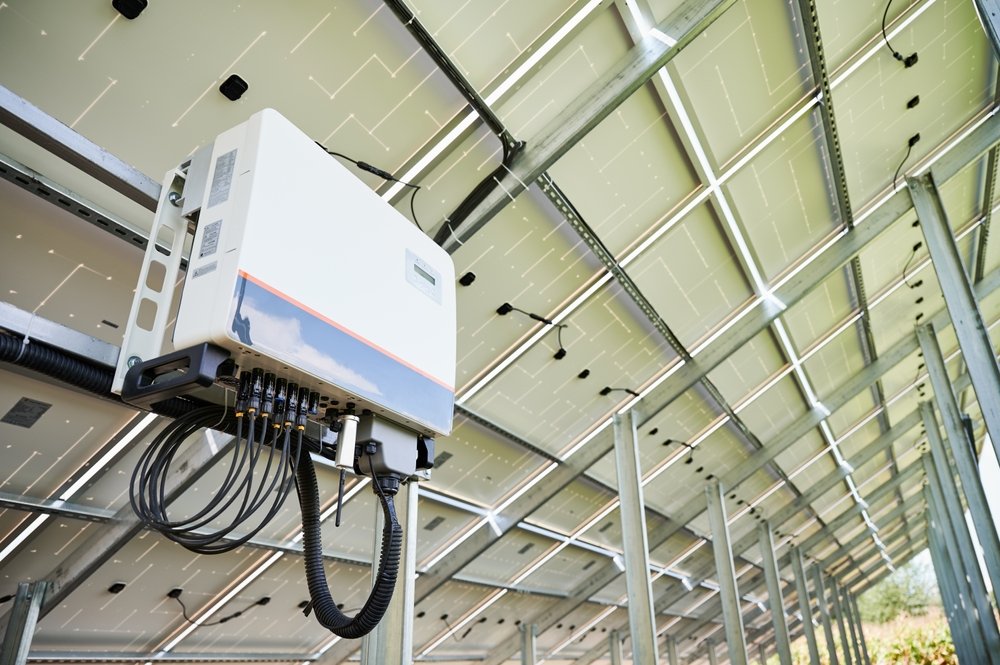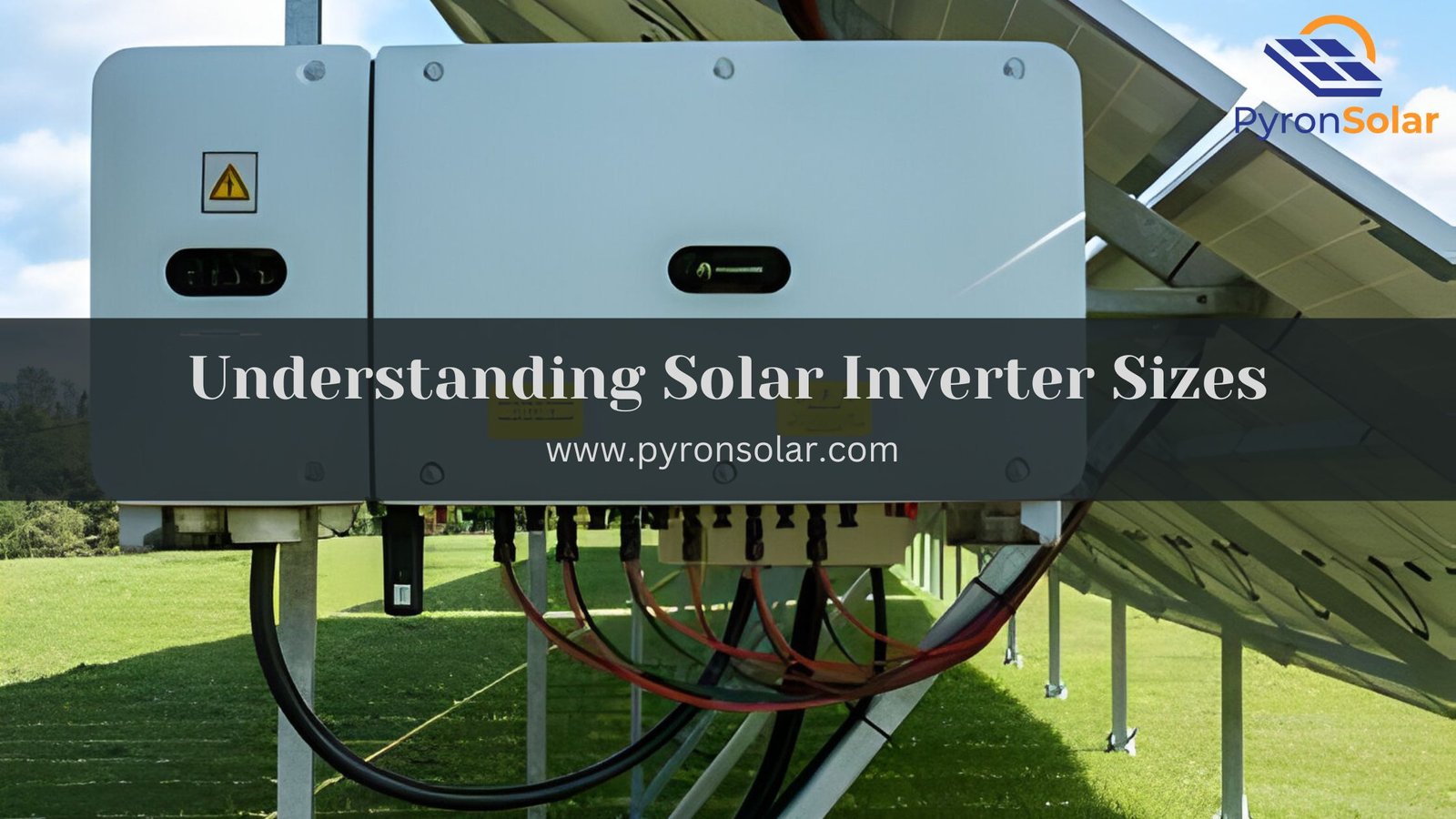Size of your inverter should closely match the DC rating of your solar panel system. For example, if you’re installing a 4-kilowatt (kW) system, the recommended inverter would typically be around 4000 watts (W), with a small allowable variation.
Solar inverter sizing is crucial for maximizing solar panel systems’ efficiency and functionality for several reasons, including optimal performance and energy production, efficient conversion process, system optimization, avoiding loss, accommodating power surges, and cost-effectiveness.

In this article, you will understand the importance of sizing solar inverters by understanding various factors such as your solar array size, geography, and site-related issues. Furthermore, you will know how to determine the right size of solar inverter and learn about the risks that occur due to oversizing, and undersizing as well as stacking your inverters to increase the power output to make the best choice.
Understanding Solar Inverters
Solar inverters play a crucial role in the DC-to-AC conversion process by activating the direction of DC input back and forth. Consequently, the DC input transforms into an AC output. Additionally, the filters and other electronics can be used to produce a steady and repeating wave of voltage which is similar to the electricity type used in the power grid. The sine wave is a particular pattern the voltage maintains over time to ensure that the power grid operates in a smooth and consistent pattern to function properly. Electrical equipments are designed to operate at specific voltages and frequencies and sine wave avoids damage to the systems.
The different types of solar inverters include:
1. String Inverters are connected to multiple solar panels and transfer DC power into a centralized inverter to create AC power.
2. Microinverters are attached to each solar panel individually to convert the DC electricity into AC electricity.
3. Power Optimizers are supportive devices for string inverters installed on the rear side of the solar panel and improve the quality and stability of DC electricity from each panel.
4. Central Inverters are the large-scale inverters used in utility plants or medium-range solar projects.
5. Battery Inverters consist of specialized batteries to store energy which is useful for providing additional backup during power outages.
6. Hybrid Inverters integrate off-grid and on-grid technologies to convert and withdraw energy from solar arrays and battery systems.
Here are more details about different types of solar inverters.
What is the Importance of Sizing Solar Inverters?
The size of a solar inverter affects the output and efficiency of the solar panel system in the following ways:
- The size of your solar array can help to handle the generated power since the inverter size should be the same as the DC rating of your solar panel system.
- Incorrect inverter size might result in power loss or efficiency, which might prevent the power from being exported to the grid.
- At times, slightly oversized solar panels compared to the inverter’s capacity can result in improved overall efficiency due to the fluctuating nature of solar irradiation throughout the day.
Factors That Determine the Size of Solar Inverters
Important factors such as the size of your solar array, location, and site-related issues determining the size of your solar inverters:
Size of Your Solar Array
The size of your solar array is a primary factor in estimating the inverter size. This is because your solar inverter converts the DC electricity that comes from the array and should have the capability to handle the complete power produced.
Based on the general rule of thumb, the inverter size should be the same as the DC rating of your solar panel system. For instance, if you are planning to install a 5 kilowatt (kW) system, you can estimate the recommended inverter to be around 5000 watts (W), allowed with a small variation.
Geography
Geography plays an essential role in estimating the size of your solar inverter due to its influence on your solar panel system’s power production. For example, the properties in Arizona experience a higher solar irradiance (a huge amount of solar radiation) than the properties in Vermont. It includes a 6 kilowatt (kW) system installed in Arizona to produce
Site-Related Factors
The site and design specifications of your solar array affect the size of your solar inverter. Similar to the geographical factors, the tilt (angle from the horizontal) and azimuth (orientation closer to the south) of your solar array can impact the amount of electricity produced by the system. By optimizing these factors, the solar energy received by the panels can be maximized. For example, panels installed at an appropriate tilt and azimuth with minimum shading and dust generate more electricity than the panels in less suitable conditions.
Derating factors can be defined as the reduced output power of solar panels to adjust for wire losses, failures due to the accumulation of dust particles, shading, high enhanced temperature, soiling, and several other factors. As a result, there is a deviation in the solar panel’s output from the estimated value. You should size your inverter slightly more than the DC rating of your solar array by considering your requirements, and it is recommended to consult a qualified professional to help you choose the correct inverter size.
How to Select the Right Size of Solar Inverters?
Matching the inverter’s wattage with the solar panel array’s total wattage holds great importance to ensure optimal DC-to-AC energy conversion process. It is important to balance the cost, efficiency, and reliability to optimize the system performance and match the inverter size with the capacity of your solar panel system.
The array-to-inverter ratio of a solar panel system is the value obtained by dividing the DC rating of your solar array by the maximum AC output of your inverter. For example, if your array is 6kW with a 6000 W, the ratio of the array to the inverter is 1, and 1:2 for a 5000W inverter.
Let’s observe some examples of different array-to-inverter ratios tabulated below:
| Product | Maximum AC Power Output | Maximum DC Power Output | Array-to-inverter ratios |
| Fronius Galvo 3.1-1 | 3100 | 4500 | 4500 / 3100 = 1.45 |
| SMA Solar Sunny Boy 5.0-US | 5000 | 7100 | 7100 / 5000 = 1.42 |
| SolarEdge SE5000H-US | 5000 | 7750 | 7750 /5000 =1.55 |
The size of your solar inverter should be equal to the DC rating of your solar panel system. Typically, the installations have a ratio between 1.15 and 1.25, with 1.2 being the optimal value. Also, a majority of manufacturers and system designers wouldn’t recommend a ratio beyond 1.55 due to the chances of huge internal heat losses.
There are certain scenarios where a slightly higher or lower array-to-inverter ratio might be advantageous:
- Higher Ratio: The decreasing module prices have resulted in reduced incremental cost of including additional DC capacity. This results in a fixed inverter with greater annual production.
- Lower Ratio: Areas with less solar radiation or high temperature diminish the panel’s efficiency and produce less power output specified by DC rating under standard testing conditions, which a slightly undersized inverter can solve.
Undersizing Your Inverter
Also called overclocking, under-sizing an inverter means using an inverter with a lower power rating than the maximum output of your solar panels. In other terms, it refers to diminishing the power output of a system under certain conditions to ensure the system reaches its peak output only for a few hours.
The potential risks and downsides of choosing an inverter that is too small for your solar panel system include:
1. Clipping: When excess DC power is fed into the inverter than its rating, the inverter generates maximum output and the extra power is simply clipped off. It means that some peak power output is lost during the midday.
2. Loss of Peak Power Output: Undersizing your inverter reduces the power output of the system under ideal conditions which might limit the number of hours the system can reach the peak output.
3. Inefficient use of system potential: A smaller power output of an inverter wouldn’t help to handle electricity generated by solar panels.
4. Equipment damage: A higher power output of an inverter can overload the system which might cause damage to the equipment. It becomes crucial to match the inverter’s power output with the solar panel array size to maximize energy production and reduce energy waste.
Oversizing Your Inverter
The method of selecting an inverter with a higher capacity rate than the maximum DC power output of the system. In simpler words, it is the pairing of a larger solar inverter with a smaller solar panel array. This strategy helps to enhance the energy produced by solar systems under low light or partial shading conditions.
Oversizing your inverter can lead to clipping when the generated DC power of your solar panel is higher than the inverter power rating. This frequently happens due to oversizing the power capacity of solar panels with a ratio greater than 1 and during noon time when the solar irradiance is above the standard value of 1000 W/m2. At this point, the additional DC power generated above the inverter rating capacity will be clipped by the inverter to ensure that it’s working at its rated value, thereby resulting in some loss of energy production.
Clipping, also known as “inverter saturation”, occurs when the DC output from the PV array is greater than the maximum input level for the inverter. Typically, the inverter alters the DC voltage to minimize the DC power by enhancing the voltage above the MPPT voltage. Also, not all inverter has the feature of self-limiting.
It is important to avoid clipping to prevent the reduction in overall efficiency, enhance lifespan, and ensure a consistent power supply.
Inverter Stacking
Installing multiple inverters in a single AC system accommodates larger loads when compared to the capacity of a single inverter, known as stacking. In other words, stacking is the procedure of how the inverters are wired within the system and configured to coordinate the operation, thereby allowing all the units to work together as a single system.
Inverter stacking can be used to increase the power output or voltage in solar panel systems in the following ways:
- The power output can be enhanced by combining the output of multiple inverters, which allows the system to handle huge energy demands without overloading even a single inverter. Running the inverters in parallel increases reliability and efficiency which results in the other inverters being able to continue the supply power regardless of a single inverter’s failure. Also, there is an option of scalability and flexibility to expand your power system when required.
- If you have two compatible inverters, then you can opt for wiring them in series and gain a higher output voltage. For instance, if you connect two 120 VAC inverters in series, the voltage gets doubled to 240 VAC and the overall power output remains the same.
Conclusion
Finally, a properly sized inverter can guarantee an efficient DC-to-AC conversion process and greatly improve the energy production of your solar system thereby avoiding issues like overloading or underutilization. As a result, higher efficiency results in less energy loss during the conversion process, which can help to increase the lifespan and reduce operational costs.
It is important to that you work with skilled professionals for inverter sizing since reputable installers offer several benefits like valuable guidance and quality components, technical support and maintenance, reliability, trust, and confidence to ensure successful outcomes.
Ray is an avid reader and writer with over 25 years of experience serving various domestic and multinational private and public energy companies in the USA.

